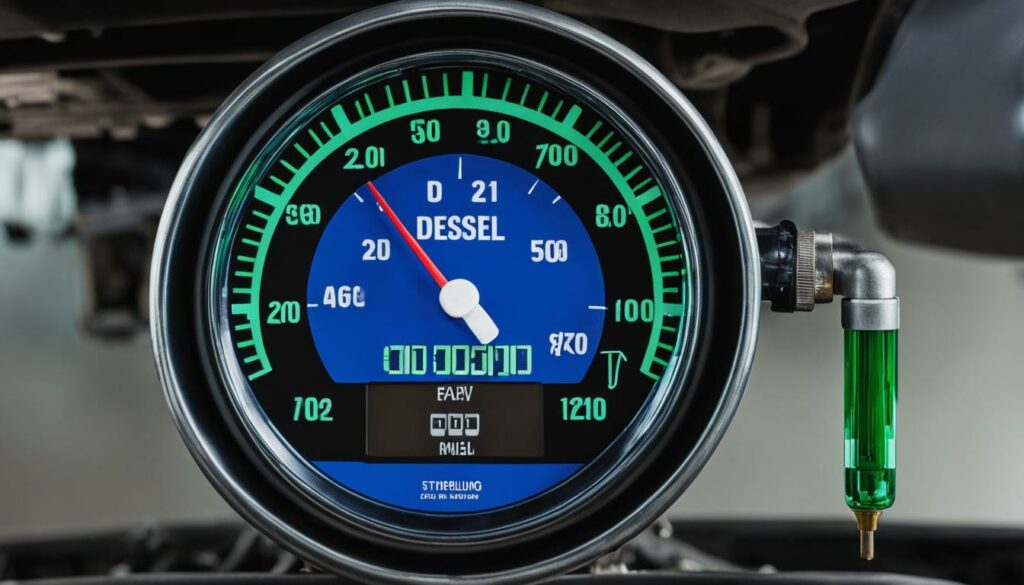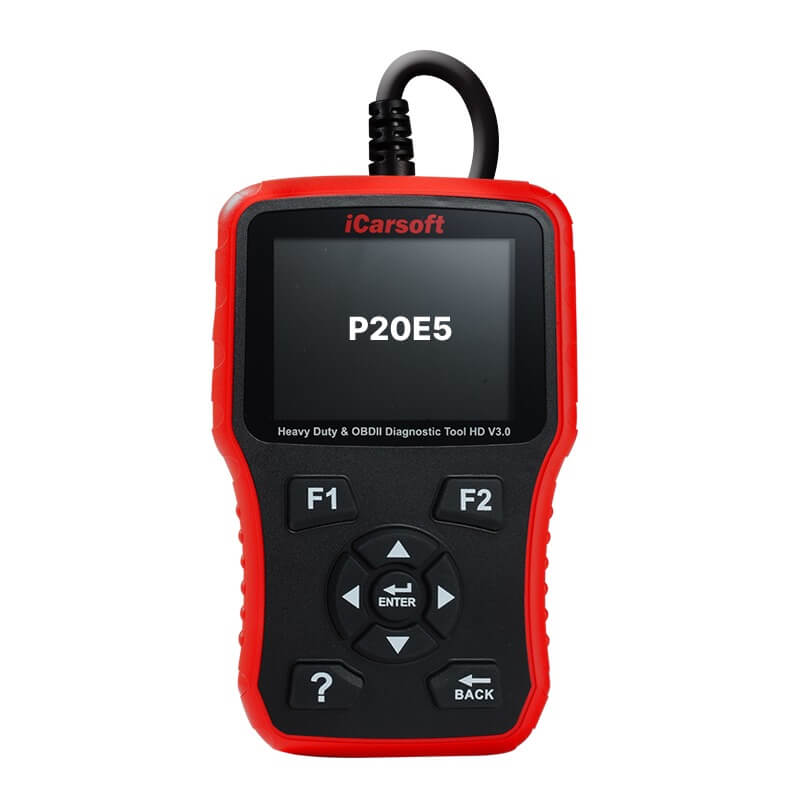P20E5 – Exhaust Gas Temperature Low for SCR System
POSTED IN pcodes
The P20E5 trouble code relates to the exhaust gas temperature being low for the selective catalytic reduction (SCR) system. This code specifically affects the emission control system in diesel vehicles and the exhaust gas temperature. The SCR system utilizes DEF (diesel exhaust fluid) to reduce NOx emissions in the exhaust gas. When the exhaust gas temperature is too low, it can impact the efficiency of the SCR system and result in increased emissions. It is crucial to troubleshoot and repair this issue to ensure proper emission control and compliance with environmental regulations.
Key Takeaways:
- The P20E5 code indicates low exhaust gas temperature for the SCR system in diesel vehicles.
- The SCR system uses DEF to reduce NOx emissions.
- A low exhaust gas temperature can lead to increased emissions and impact engine performance.
- Troubleshooting and repairing the issue is important for proper emission control.
- Professional assistance or alternative solutions, such as permanent code removal, should be considered if needed.
Symptoms and Causes of P20E5 – Exhaust Gas Temperature Low
When dealing with the P20E5 – Exhaust Gas Temperature Low issue in the SCR system, it’s important to be aware of the symptoms and causes associated with it. By understanding these indicators, you can effectively troubleshoot and address the problem.
Common Symptoms
The following symptoms may occur when experiencing the P20E5 code:
- The check engine light illuminates on the dashboard.
- Reduced engine performance.
- Affected fuel economy.
- Presence of black smoke emitting from the exhaust pipe.
These symptoms indicate that the exhaust gas temperature is operating at a low level. It’s crucial to take action to prevent any further complications.
Possible Causes
Various factors can lead to the exhaust gas temperature being low in the SCR system. The causes of the P20E5 code may include:
Buy tested tuning file for Adblue / EGR / DPF / Adblue off now!
- Malfunctioning exhaust gas temperature sensor.
- Open or shorted sensor harness.
- Substandard electrical connections in the sensor circuit.
- Leaks in the exhaust system.
- Excessive particulate matter buildup on the sensor.
Identifying and addressing these causes is essential to resolve the P20E5 code and maintain proper functioning of the SCR system for effective emission control.
Now that we have examined the symptoms and causes of P20E5 – Exhaust Gas Temperature Low, let’s move on to Section 3 where we will explore the troubleshooting and repair steps for resolving this issue.
Troubleshooting and Repair for P20E5 – Exhaust Gas Temperature Low
To effectively troubleshoot and resolve the P20E5 code related to exhaust gas temperature low in the SCR system, it is essential to follow a systematic approach. By taking the following steps, you can address the issue and restore proper emission control in diesel vehicles.
1. Repair or Replace the Faulty Exhaust Gas Temperature Sensor Circuit
The first step in troubleshooting is to inspect and repair any faults in the exhaust gas temperature sensor circuit. Check for loose connections, damaged wiring, or corrosion that may be interfering with the sensor’s functionality. If necessary, replace the faulty sensor circuit to ensure accurate readings of the exhaust gas temperature.
2. Rehabilitate Defaults in the Sensor Harness
Next, carefully examine the sensor harness for any defaults or abnormalities. Look for signs of wear and tear, insulation damage, or exposed wires. It is crucial to address any issues with the sensor harness to maintain proper communication between the sensor and the SCR system.
3. Replace the Exhaust Gas Temperature Sensor if Necessary
If the sensor itself is found to be faulty or damaged beyond repair, it is necessary to replace it. Ensure that the replacement sensor is compatible and of high quality to guarantee accurate temperature readings for optimal SCR system performance.
4. Repair or Replace Circuit Wiring and Connectors
Inspect the circuit wiring and connectors associated with the exhaust gas temperature sensor. Look for any signs of damage, corrosion, or loose connections. It may be necessary to repair or replace the wiring and connectors to establish a reliable electrical connection and restore functionality.
5. Reprogram the Controller and PCM
Reprogramming the controller and the powertrain control module (PCM) can help resolve any software-related issues that might be contributing to the P20E5 code. Consult the manufacturer’s guidelines and use the appropriate software tools to reprogram these components and ensure they are up to date.
6. Inspect and Replace Other Components as Needed
Perform a thorough inspection of other components in the SCR system that may impact the exhaust gas temperature. Check the EGR (exhaust gas recirculation) valve, the diesel exhaust fluid pump, the fuel injection system, and the engine wiring harness for any faults or malfunctions. Replace or repair these components as necessary to restore proper functionality.
Professional Assistance for P20E5 – Exhaust Gas Temperature Low
If professional assistance is not available or for those who prefer an alternative solution, there is an option for the permanent removal of the P20E5 code. This involves uploading the Engine Control Unit (ECU) file to a designated portal. By doing so, the specific Pcode can be permanently removed. This option provides an efficient way to address the issue without the need for extensive troubleshooting and repairs. It is important to consider professional assistance or the alternative solution to ensure the proper functioning of the diesel engine and SCR system.

When it comes to resolving the P20E5 – Exhaust Gas Temperature Low code, seeking professional assistance can be invaluable. Trained technicians have the expertise and diagnostic tools to accurately identify the underlying cause of the issue and provide precise solutions. They can perform comprehensive diagnostics to pinpoint the faulty components, such as the exhaust gas temperature sensor or other SCR system elements. Additionally, they can ensure that any repairs or replacements are done correctly, maintaining the optimal performance of the diesel engine and SCR system.
Professional assistance offers several key advantages:
- Expertise: Technicians specializing in diesel engines and emission control systems have in-depth knowledge and experience in dealing with P20E5-related issues. They stay updated on the latest diagnostic procedures and repair techniques.
- Diagnostic Tools: Professional workshops are equipped with advanced diagnostic tools specifically designed for diesel engines and SCR systems. These tools enable accurate troubleshooting and help identify the precise cause of the P20E5 code.
- Quality Repairs: Professional technicians have access to genuine OEM (Original Equipment Manufacturer) parts, ensuring high-quality replacements that meet manufacturer specifications. This guarantees that all repairs are performed to the highest standards.
- Efficiency: With professional assistance, the troubleshooting and repair process can be expedited, minimizing vehicle downtime and inconvenience. Trained technicians can efficiently diagnose and address the P20E5 issue, restoring the proper functioning of the SCR system.
Overall, seeking professional assistance for the P20E5 – Exhaust Gas Temperature Low code provides peace of mind, as experts handle the diagnosis and repair process. This ensures the optimal performance of the diesel engine and SCR system, promoting effective emission control and compliance with environmental regulations. Additionally, professional technicians can offer valuable advice and preventive maintenance recommendations to avoid similar issues in the future.
Conclusion
In conclusion, the P20E5 code indicates that the exhaust gas temperature is low for the SCR system in diesel vehicles. This can lead to increased emissions and affect the overall performance of the engine. It is crucial to identify and address the underlying causes of this issue, which can include a malfunctioning exhaust gas temperature sensor or issues with the SCR system components.
Troubleshooting and repair steps should be followed to rectify the problem, ensuring that the exhaust gas temperature is optimized for proper emission control. If you are not familiar with the complexities of the SCR system and its components, it is recommended to seek professional assistance. A certified technician can diagnose the issue accurately and provide expert guidance on the necessary repairs.
For those who prefer an alternative solution, there is the option for the permanent removal of the P20E5 code. This option, however, should only be considered after careful evaluation and consultation with professionals, as it may have legal and environmental implications. It is important to prioritize both the effective functioning of the SCR system and compliance with emission control regulations.
By taking the necessary steps to address the P20E5 code, whether through troubleshooting, repairs, or professional assistance, you can ensure that your diesel vehicle’s SCR system operates optimally, reducing emissions and contributing to a cleaner environment.
FAQ
What does the P20E5 trouble code indicate?
The P20E5 trouble code indicates that the exhaust gas temperature is low for the selective catalytic reduction (SCR) system.
What is the SCR system and why is the exhaust gas temperature important?
The SCR system is an emission control system in diesel vehicles that uses a DEF (diesel exhaust fluid) to reduce levels of NOx emissions in the exhaust gas. The exhaust gas temperature is important for the efficiency of the SCR system and proper emission control.
What are the symptoms of P20E5 – Exhaust Gas Temperature Low?
Common symptoms include the check engine light illuminating, reduced engine performance, affected fuel economy, and black smoke emitting from the exhaust pipe.
What are the common causes of P20E5 – Exhaust Gas Temperature Low?
The common causes can include a malfunctioning exhaust gas temperature sensor, open or shorted sensor harness, substandard electrical connections, leaks in the exhaust system, or excessive particulate matter buildup on the sensor.
How can I troubleshoot and repair the P20E5 code?
Troubleshooting steps can include repairing or replacing the faulty exhaust gas temperature sensor circuit, rehabilitating any defaults in the sensor harness, replacing the exhaust gas temperature sensor if necessary, replacing or repairing circuit wiring and connectors, reprogramming the controller and PCM, and inspecting and replacing other components as needed.
Is there an alternative solution for the P20E5 code removal?
Yes, there is an option for permanent removal of the P20E5 code by uploading the Engine Control Unit (ECU) file to a designated portal.
Should I seek professional assistance for the P20E5 code?
Professional assistance is recommended to ensure proper functioning of the diesel engine and SCR system. However, if professional assistance is not available, the alternative solution for permanent code removal can be considered.


